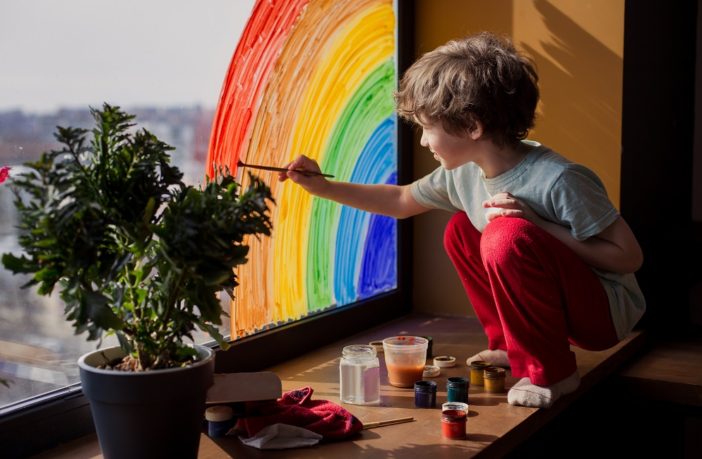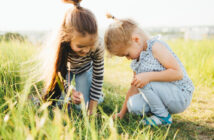Although select year groups have returned to nursery and school, there are still a large proportion of parents continuing to educate their children from home. Open University (OU) academics from the School of Education, Childhood, Youth and Sport (ECYS) have joined forces to provide their tips on creative play – a form of learning that gives children freedom to satisfy their need for self-expression, whilst still developing physical, cognitive, emotional and social skills.
How to play creatively
Dr Jane Dorrian, Staff Tutor and mother to a son, aged 15, introduces us to the topic:
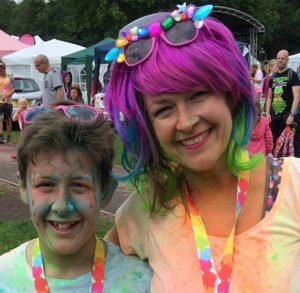 The most important rule of creative play is that there are no rules – if you start out thinking that you and your child are going to be painting a flower and you end up singing a song about a dinosaur, then you have definitely been playing creatively. Young children see the world differently because their understanding of how everything works is still developing. Creative play is the perfect way to support your child’s understanding because it doesn’t have a right answer or a correct method – it lets you explore and experiment together.
The most important rule of creative play is that there are no rules – if you start out thinking that you and your child are going to be painting a flower and you end up singing a song about a dinosaur, then you have definitely been playing creatively. Young children see the world differently because their understanding of how everything works is still developing. Creative play is the perfect way to support your child’s understanding because it doesn’t have a right answer or a correct method – it lets you explore and experiment together.
It’s helpful to have a task to begin with, there are lots of websites with great ideas (try the CBeebies Get Creative App or ABC Does). Most people feel comfortable starting with hands-on activities. If you think you haven’t got the resources to be creative, just look in your recycling bin and you’ll find milk cartons waiting to become maracas, cereal boxes desperate to be statues, newspapers yearning to transform into costumes – and if you can’t see what something could be, ask your child, that’s a great way to start a creative journey.
Adults often feel pressured to have a finished product at the end of a creative activity and that focus on outcome is where creativity gets lost. The temptation to help by making suggestions or showing them how to do something ‘the right way’ is part of being a parent, but creative play switches the roles, so let go.Try to encourage your child to talk whilst they’re playing and follow their ideas, the crazier they are the more creative the play.
Asking children to think about senses in unexpected ways is a helpful approach to develop creative ideas whilst you’re playing. As an example, try asking how a colour would sound or what a dance movement would taste like – and give them time to answer. Carry on playing while they’re thinking, it doesn’t matter if they don’t have an answer, answer with another question, or if they don’t answer at all, they might be so involved in what they are doing they haven’t got the head-space to deal with your question. Very young children may not have the vocabulary to express their response, so just letting them be in the moment is an important part of being creative.
Let your child decide when the task is finished, sometimes children like to return to activities and other times they feel the work is complete. It’s important to let them have time to process what they have done so avoid asking lots of questions about what they liked or how they felt before the paint is even dry. Asking them to explain the activity to someone else is a good way to find out what they thought was the most memorable part, and remember that a negative response to an activity is fine – we all like different music and art and children are no different. The more opportunities they have to develop their understanding and explore different ways of doing things the more creative they become.
Other techniques
Kieran McCartney, Staff Tutor and father to three children aged 14, 12 and seven, discusses the concept of ‘raffling your time’:
 One of the areas we found quite challenging is that our youngest child requires much more direction when it comes to structuring her day. She would often refuse to do any mental maths and would even turn down reading if she wasn’t in the right mood. In her defence I would refuse to do mental maths, where it was possible.
One of the areas we found quite challenging is that our youngest child requires much more direction when it comes to structuring her day. She would often refuse to do any mental maths and would even turn down reading if she wasn’t in the right mood. In her defence I would refuse to do mental maths, where it was possible.
We thought that providing a clear structure for her day would make life easier for her but outside the school context somehow, it just didn’t seem to work. So, we applied the Einstein maxim that insanity (at least in relation to how we taught our daughter) was doing the same thing repeatedly and expecting different results. We wanted our daughter to engage in the learning, so we took a slightly different approach and introduced a game called ‘raffle your time’.
In this game we left the choice of topic our daughter would study, to chance. We used some polystyrene egg shapes and using a pen to write a different topic on each one. Then:
- We placed the topic choices in a small plastic bowl and asked our daughter to close her eyes and choose an egg
- The agreement was that whatever came out of the bowl as a choice would be the topic that was studied
- Once that topic was chosen it was then removed from the bowl for that day
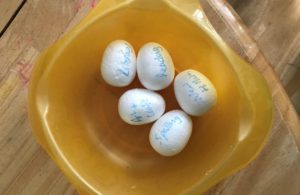 After completing the task associated with the topic our daughter would take a break and we would repeat the process a few more times.
After completing the task associated with the topic our daughter would take a break and we would repeat the process a few more times.
So far, so good. The random nature of the choices seems to have helped remove the ‘dread’ or reluctance our daughter felt and left the choices of learning to chance and not the product of the school of Mum and Dad.
Helping hands with the housework
Steph Doehler, Staff Tutor and mother to a daughter aged three, explains how she engaged her child in everyday household activities:
 Four days prior to Boris Johnson’s announcement that the UK would, in some fashion, be shutting down for the foreseeable future, we bought a new house; one that we knew we would keep us busy – painting the rooms, pulling up laminate flooring, fixing the decking, painting the fence – the list goes on.
Four days prior to Boris Johnson’s announcement that the UK would, in some fashion, be shutting down for the foreseeable future, we bought a new house; one that we knew we would keep us busy – painting the rooms, pulling up laminate flooring, fixing the decking, painting the fence – the list goes on.
Juggling this already stressful time with me in a relatively new job (having joined the OU full time in February), my partner new to working from home and having a three-year-old to keep entertained, has been a challenge. But, like so many others, we have had to work around it and do the best we can. With that in mind, we created a list of all the tasks we needed to do over the first four weeks in the new house (most of which are mentioned above). Now the difficulty was to do all of this with a small person in tow.
Painting the walls? No problem – three-year-old donned her dirty clothes, picked up a brush and helped paint her own bedroom. Whilst her attention span came and went, it entertained her for most the day (though, admittedly, we did have to stop for regular snack breaks).
Fixing the decking? Absolutely fine. She decided her role in the process was to move all the stones from one end of the garden to an open gap under the decking. Given that we are going to be laying turf soon, that is another job ticked off the list.
Cleaning the house? For some reason, she loves dusting. That said, last time we tried to encourage her away from the television to clean the skirting boards she retorted with some demands: “One penny for my piggy bank and one sweetie.” She had herself a deal.
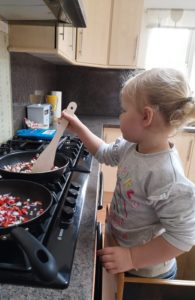 Perhaps our favourite way of getting her involved though is through cooking. Armed with the kitchen tower that makes her just the right height for the worktops, she has helped make paella, chicken parmigiana, homemade pizzas and burgers. Favourite tasks include grating the cheese (usually because she eats some along the way), taking the ‘coats off the mushrooms’ (i.e. peeling them), whisking eggs and, her number one task, pouring herbs into dishes.
Perhaps our favourite way of getting her involved though is through cooking. Armed with the kitchen tower that makes her just the right height for the worktops, she has helped make paella, chicken parmigiana, homemade pizzas and burgers. Favourite tasks include grating the cheese (usually because she eats some along the way), taking the ‘coats off the mushrooms’ (i.e. peeling them), whisking eggs and, her number one task, pouring herbs into dishes.
Now, don’t get me wrong, this isn’t always a complete success. We have had whole eggs being thrown into bowls, paint on the floor (thankfully the new carpets hadn’t been laid by that point), several declarations of “I’m too tired” and more falling over than I care to count. But in this really challenging time for everyone, getting her to help, giving her realistic tasks and making them fun has made our life infinitely easier.
Top tips
- Don’t worry about producing a masterpiece – the process is more important than the product
- Really listen to your child’s ideas, give them time to explain their thoughts without interruption
- Don’t be afraid of silence, you don’t need to constantly ask questions or make observations
- The contents of your recycling bin are all the resources you need
- Enjoy yourself – it isn’t a test and there are no right answers
- Recognise we don’t know what is going through our children’s heads or what they’re experiencing, we’re living in unprecedented times
- Whilst structure is good allow for a lack of structure
- Don’t underestimate how much children can do – they can get involved in most household tasks.
- Make it fun – who can dust the fastest? Race to fill your wheelbarrow with stones, etc.
- Give ownership and choice
Find out more
About Early Years courses at the OU.
The OU’s free learning site, OpenLearn also has a number of free courses on Education & Development.
